Global Ornamental Fish Market Forecast
- Ornamental fish market size to take a leap from US$US$6.3 Bn in 2022, to approximatrly US$11.6 Bn in 2030
- Market valuation poised to see a robust CAGR of 8.8% between 2023 and 2030
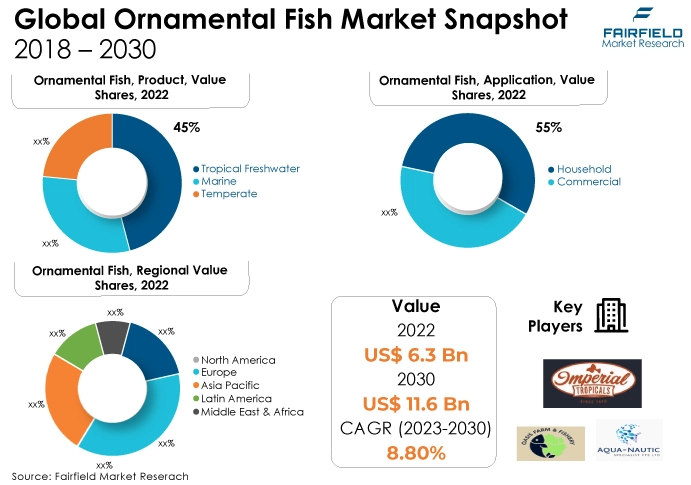
Quick Report Digest
- The key trend anticipated to drive the ornamental fish market growth is the increasing use of technology in fishkeeping. Supporting the development of corals and aquatic plants not only improves the aesthetic appeal of aquariums but also increases consumer demand for these species.
- Another major market trend expected to drive the ornamental fish market growth is the rapidly expanding interest in fish breeding. The growing interest in breeding has prompted the creation of specialized tools and supplies made specifically for breeders. This creates a specialty market area that includes breeding tanks, egg incubators, and rearing tanks.
- The ornamental fish market faces competition from other pet options, including dogs, cats, and small mammals. These alternatives may be more popular in some regions and can divert consumer spending away from ornamental fish.
- In 2022, the tropical freshwater category dominated the industry. Tropical freshwater fish can be maintained in a variety of aquariums of different sizes and types. These may include biotope aquariums, glass tanks, and acrylic tanks.
- The marine segment is anticipated to increase at the fastest rate of the ornamental fish market during the forecast period. Marine aquariums, often known as saltwater tanks or reef tanks, are created specifically to hold attractive fish and invertebrates from the ocean.
- In 2022, the household category dominated the industry. The market for household ornamental fish includes a wide range of tools and supplies, including substrate materials, air pumps, heaters, lighting systems, filters, and water conditioners, all of which are intended to establish and maintain a healthy aquatic environment.
- Asia Pacific region dominates the ornamental fish market during the forecast period. Due to the region's expanding middle class, there is more money available for hobbies and animals, particularly ornamental fish.
- Europe is expected to be the fastest-growing ornamental fish market region. A significant and established industry for ornamental fish exists in Europe, where both freshwater and marine species are in high demand. The population of the area is diversified and wealthy, which supports this desire.
A Look Back and a Look Forward - Comparative Analysis
Living in an urban area typically means having restricted access to outdoor green spaces. In order to provide a sense of tranquility and nature to their urban homes, individuals turn to indoor hobbies like raising ornamental fish.
Home aquariums now include distinctive underwater landscapes due to urban populations' interest in indoor gardening and aquascaping. This trend drives the demand for live aquatic plants and complementary decorative fish. Because urban residents frequently have limited room, micro and nano aquariums that may easily fit in smaller apartments or homes are becoming increasingly popular.
The market witnessed staggered growth during the historical period 2018 - 2022. Investor trust increased as companies engaged in ornamental fish production and pollution control technology proved their adherence to emission standards and made a positive impact on the environment.
Industrial boilers were equipped with ornamental fish-based catalysts to lower NOx emissions, resulting in better air quality and adherence to environmental laws. Control of diesel engine emissions, which was frequently utilized in commercial applications, was given a lot of attention. To successfully minimize NOx emissions, diesel vehicles' catalytic converters have to include substantial amounts of ornamental fish.
Captive-bred species are frequently preferred by sustainable pet ownership over those taken from the wild. Nowadays, a lot of ornamental fish sold on the market are produced under controlled conditions, which eases the strain on wild fish populations and ecosystems in the coming years.
Additionally, consumers increasingly demand transparency in the supply chain, wanting to know the source of the fish they purchase. Businesses that provide traceability and information about the origins of their fish can gain consumer trust.
Consumers are also reassessed by certification programs and industry standards, which encourage ethical business practices in the ornamental fish sector, such as those relating to sustainable sourcing and ethical breeding during the next five years.
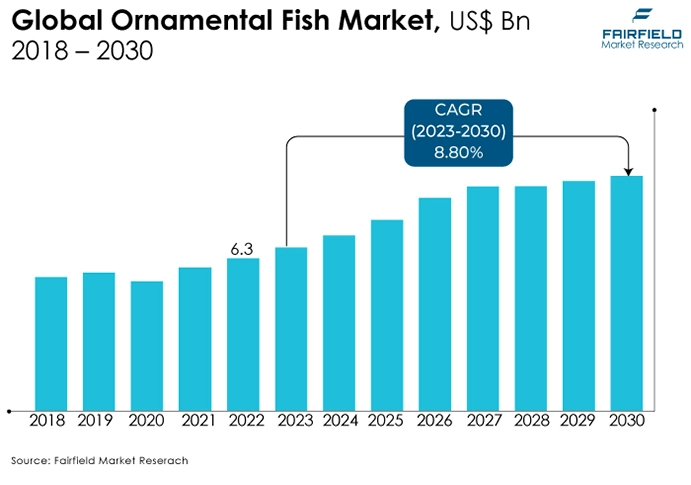
Key Growth Determinants
- Rising Spending Power of Consumers
People are more likely and able to spend money on non-essential products like ornamental fish and aquarium materials when they have more spare income. The market for ornamental fish sees stronger sales as a direct result of this improved purchasing power.
As disposable income increases, a larger group of people may afford to take up the hobby of raising ornamental fish. This broadens the client base for ornamental fish and related products by including both long-time enthusiasts and newcomers.
Hobbyists are more likely to spend their extra cash on premium and uncommon fish species as well as high-end aquarium supplies and accessories. This increases consumer demand for a wider range of fish and accessories, fueling market expansion.
- Growing Interest in Aquascaping
Intricate underwater landscapes are frequently crafted through the practice of aquascaping, and the fish species used are chosen for their ability to enhance the design. This increases demand for particular fish species that are appropriate for aquascaping, such as vibrant and tranquil community fish, nano fish species, and bottom-dwelling fish.
Using live aquatic plants to create lush underwater gardens is a key component of aquascaping. Due to hobbyists' frequent acquisition of both fish and plants for their aquascaping endeavors, the demand for these plants is closely related to that of the ornamental fish industry.
To keep both fish and plants in the best possible conditions, aquascaping fans spend a lot of money on premium aquarium equipment, including CO2 injection systems, top-notch lighting, and cutting-edge filtration systems. Specialized aquarium accessories sell better as a result.
- Pacing Adoption for Aquarium Technology
Modern filtration systems maintain improved water quality and ideal circumstances for fish health. Because of the decreased risk of disease outbreaks and increased longevity of ornamental fish, more people are drawn to this activity.
Aquarists can now measure water parameters like pH, ammonia, and nitrate levels more easily due to automated water testing and monitoring equipment. This guarantees the fish a stable and healthy habitat and shortens the learning curve for novices.
Automatic fish feeders make it possible to feed fish consistently and under control, avoiding overfeeding or skipping meals while hobbyists are away. The fish's wellbeing is enhanced by this feature, which also eases maintenance worries.
Major Growth Barriers
- Stringent Regulations and Compliance Issues
The international trade in ornamental fish frequently involves complicated import and export procedures, such as the need for licenses, health certifications, and adherence to Convention on International Commerce in Endangered Species (CITES) rules. These regulatory processes can be costly and time-consuming for businesses.
Strict quarantine regulations are in place in many countries to stop the spread of diseases and parasites in the ornamental fish trade. Fish breeders and exporters may experience delays and increased expenses when shipments are subject to lengthy quarantine procedures.
- Limited Access to Rare Species
Rare and exotic fish species frequently have a special allure for hobbyists and collectors. The range of fish accessible on the market is constrained when access to certain species is restricted because of export restrictions, low availability, or high prices. Consumer interest and demand may decline as a result of this.
Businesses that specialize in providing uncommon and unique fish species could experience difficulty getting access to their main products. Because they can find it difficult to set themselves apart from rivals who offer more readily available species, this can lessen their edge in the market and profitability.
Key Trends and Opportunities to Look at
- Rising Online Fish Sale
Geographical restrictions can be overcome by ornamental fish providers using online platforms to connect with a worldwide clientele. Breeders and merchants can reach consumers in other areas, increasing the scope of their potential market.
Consumers can shop conveniently online. From the convenience of their homes, they can browse a large range of fish species and related supplies. More people are exploring the hobby of raising ornamental fish due to this accessibility. More fish species, including rare and exotic varieties, can be found in online marketplaces.
Hobbyists and collectors who are looking for particular species that might not be easily accessible in neighborhood pet stores will be drawn to this broad collection.
- Sustainable and Ethical Sourcing
Customers have more faith in businesses that source ethically and sustainably. Customers are more likely to support companies that put fish and the environment first. This confidence may result in repeat business and client loyalty. More people are becoming interested in the hobby of keeping ornamental fish as awareness of ethical and environmental issues rises.
The consumer base is growing, which could result in more demand for ornamental fish and related products. Companies that maintain ethical and sustainable standards can set themselves apart from the competition. They can use their dedication to ethical sourcing as a differentiator to draw in conscientious customers.
- Increasing Focus on Nano and Small Aquariums
Smaller aquariums, such as micro tanks, take up less room and are suitable for apartments, offices, and other compact spaces. This broadens the pool of possible customers by appealing to those who live in urban areas and those who have small homes. Compared to larger aquariums, nano and mini aquariums often require less upkeep.
For beginners and those who lead busy lives who might be hesitant to invest in larger, more time-consuming tanks, this makes them an appealing option. Setting up and maintaining smaller aquariums is typically more affordable. This accessibility to ornamental fishkeeping promotes newbies to the hobby and opens it up to a larger audience.
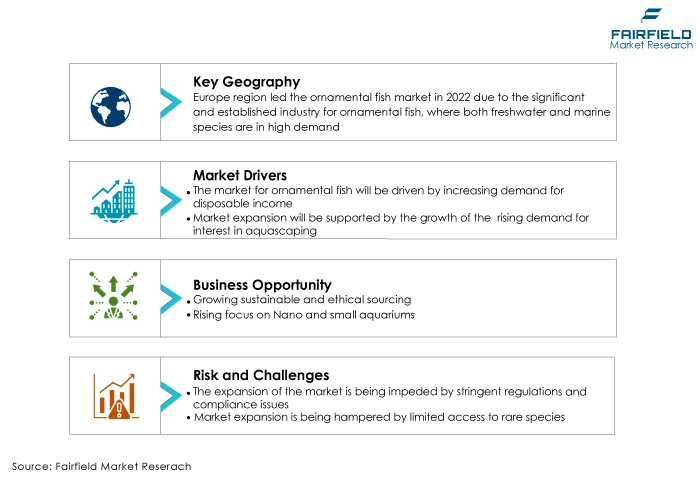
How Does the Regulatory Scenario Shape this Industry?
Over the last three years, the ornamental fish market has been managed on both a national and global scale by a number of regulatory frameworks designed to assure fish welfare and protect ecosystems. An international treaty known as the CITES of Wild Fauna and Flora was created t o control and monitor the trade of threatened and endangered species, including several species of ornamental fish.
The availability of some fish species on the market may be affected by CITES designations that limit or regulate fish trading. When transacting with listed species, businesses must adhere to CITES requirements. Laws in the European Union govern the importation and trade of ornamental fish. This includes steps to prevent sickness and health certification.
Companies exporting ornamental fish to the EU market are required to comply with EU laws. These laws have an impact on the importing, handling, and sourcing of ornamental fish. In the US (USDA-APHIS), the United States Department of Agriculture - Animal and Plant Health Inspection Service is in charge of regulating the importation of live animals, including ornamental fish and enforcing laws to stop the spread of illness.
Importers are required to abide by USDA-APHIS laws, which include those regarding health certification and quarantine procedures. This may impact the supply of imported ornamental fish.
Fairfield’s Ranking Board
Top Segments
- Dominance of Tropical Freshwater Category Prevails
The tropical freshwater segment dominated the market in 2022. All across the world, ponds and aquariums are home to these typical house pets. There are many different types of tropical freshwater ornamental fish, each with unique characteristics and maintenance requirements.
Several popular tropical freshwater ornamental fish species include goldfish, betta, mollies, tetras, and guppies. New pet owners choose to maintain tropical freshwater ornamental fish because they are simple to care for and come in a variety of colors.
Furthermore, the marine category is projected to experience the fastest market growth. These fish species can be identified by their striking colors, intricate patterns, and unique shapes.
Marine ornamental fish are typically more challenging to keep than freshwater fish since they require specialized equipment and water conditions. Due to the variety of saltwater fish species and colors, reef aquariums and fish-only aquariums are subcategories of marine aquariums.
- Households Remain the Largest Consumer Segment
The household segment dominated the market in 2022. Ornamental fish are increasingly being used in homes because they enhance the attractiveness of a neighborhood. Another important element boosting the demand for ornamental fish around the world, notably in the growing countries of India, China, and Brazil, is the rise in household income brought on by economic expansion.
Smart technological developments are also motivating more people to become aquarium hobbyists, which is pushing more people to buy decorative fish for their homes. During the forecasted period, the commercial category is expected to expand substantially. The popularity of ornamental fish in the business sector has been fueled by the rising installation of aquariums in the hotel industry as a tool for promoting stress alleviation programs through fish-keeping.
A further factor increasing product demand from the business sector is the idea of underwater hotels in the hospitality industry. For instance, the only underwater hotel in the United States is Jules Undersea Lodge, an American establishment situated in Key Largo, Florida.
Regional Frontrunners
Asia Pacific Contributes the Largest Share
The ornamental fish market holds a major share in Asia Pacific in terms of value. One of the most significant markets for ornamental fish in the world evolved in the region is headed by China, Japan, and India. It is possible to attribute the rising demand for high-end and exotic ornamental fish to the growth of the local market.
The need for a variety of odd fish species has increased due to the prevalence of fish in Japanese art culture. Opportunities for market expansion exist because elite Asians value rare exotic fish as a status symbol. For instance, the Asian Arowana is one of the most expensive aquatic species in the world, with prices that can reach US$300,000 or more.
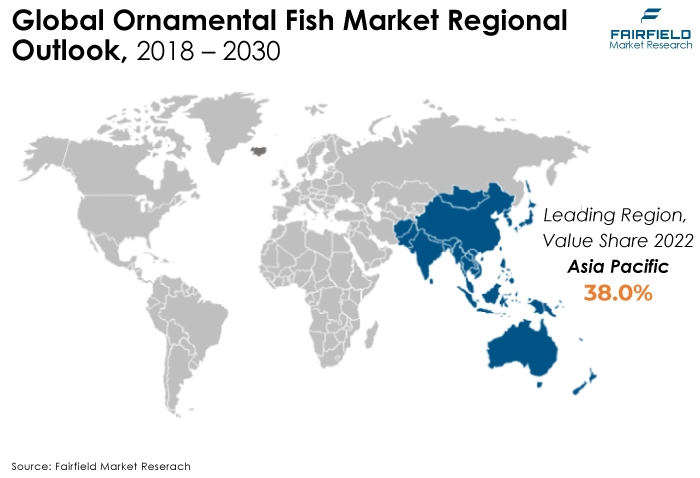
Europe Likely to Witness the Significant Growth in Sales During Forecast Period
During the projected period, Europe is anticipated to witness the fastest growth in the ornamental fish market. This is because of the extensive importation of ornamental fish from Asian nations like Singapore, Thailand, and Japan to satisfy the region's enormous demand for ornamental fish. Ornamental fishes also contribute to import and export activities, as well as foreign exchange, because keeping fish is a simple and stress-relieving hobby.
Moreover, various ornamental fish are now grown, according to the University of Florida's Institute of Food and Agricultural Sciences, in European nations such as the Czech Republic, Spain, Israel, Belgium, and Holland. Additionally, it is becoming more profitable to produce fish close to consumer hubs due to cheap transportation costs.
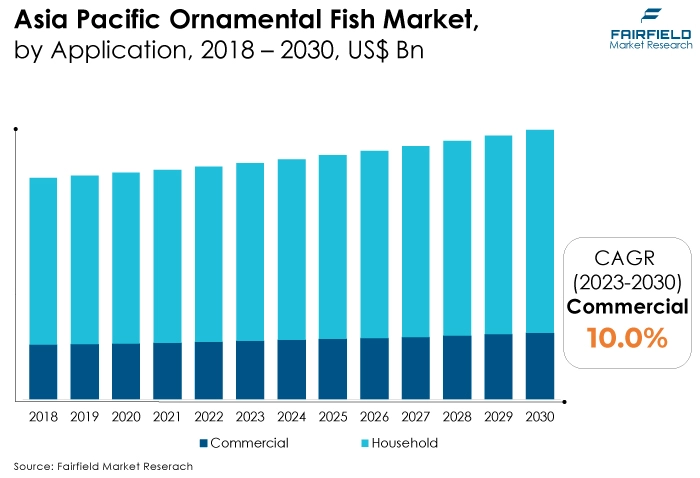
Fairfield’s Competitive Landscape Analysis
Several well-known companies operate in the fiercely competitive ornamental fish market. To boost their market share globally, big businesses are producing new items, launching innovative products, and growing their distribution networks. Moreover, Fairfield Market Research is expecting the market to witness more consolidation over the coming years.
Who are the Leaders in the Global Ornamental Fish Space?
- Aqua-Nautic Specialist Pte Ltd.
- bioAquatiX
- Imperial Tropicals
- LiveAquaria
- Oasis Fish Farm
- Sanyo Aquarium (Pte) Ltd.
- Qian Hu Corporation Limited
- Sunbeam Aquarium Pte Ltd.
- Tropical Fish International Pte Ltd.
- Segrest Farms
- Neptune Aquatics
- Aqua Leisure International
- Tropical Marine Centre (TMC)
- Blue Zoo Aquatics
- Rising Sun Farm
Significant Company Developments
New Product Launches
- September 2023: A brand-new pet food business launched a type of cat food made with ornamental fish. The industry asserts that the meal is healthier and more sustainable than regular cat food.
- June 2020: A new hatchery building and a quarantine facility have been added, according to a statement from Blue Ridge Fish Hatchery. With this growth, the business will be able to produce more koi and goldfish while upholding its stringent requirements for fish health and quality.
- March 2020: Aqua Leisure launched its 'Aquarium Life' product line, which consists of a variety of aquarium décor, filters, and food. In order to exhibit its goods and give clients access to educational materials on aquarium maintenance, the company recently established a new website.
Distribution Agreements
- December 2021: An agreement was signed between Qian Hu Corporation Limited and AquaEasy Pte Ltd. to help prawn farmers follow sustainable aquaculture practices and boost production and profit while minimizing risks and costs. Based on the ability to analyze data, AquaEasy integrates sensors, software, and services.
- November 2021: Imperial Tropicals partnered up with the Japanese fish food company Hikari. All varieties of fish, whether farmed or taken in the wild, can use this brand of feed. In order to maintain the health of their fish, this cooperation enabled customers to become familiar with the brand of fish food.
An Expert’s Eye
Demand and Future Growth
As per Fairfield’s Analysis, consumer evaluations and ratings are frequently used by online shoppers to guide their purchases. Positive comments and feedback can enhance the credibility of breeders and vendors, increasing assets.
Furthermore, Customers may easily find decorative fish and related products because of specialized internet marketplaces devoted to pet and aquarium products. These platforms frequently bring a diverse range of suppliers and consumers together, fostering market growth. However, the ornamental fish market is expected to face considerable challenges because of stringent regulations and compliance issues.
Supply Side of the Market
According to our analysis, almost 80% of the world's ornamental fish market is supplied by Asia Pacific, which also produces and exports the most of any region. Indonesia, Thailand, Vietnam, China, India, and Malaysia are some of the largest producers in the Asia Pacific region. Approximately 10% of the world's ornamental fish market is supplied by North America, which is also the second-largest producer and exporter of these species.
The United States, Canada, and Mexico are the three most important producing nations in North America. With more than 25% of the world's ornamental fish demand, China is the largest consumer globally. The enormous and expanding population of the nation, customers' rising disposable money, and the growing acceptance of fishkeeping as a pastime all contribute to the demand for ornamental fish in China.
With nearly 10% of the market share in Asia Pacific, Japan is the second-largest consumer of ornamental fish. The high level of living in Japan, the prevalence of fishkeeping as a hobby, and the expanding knowledge of the advantages of owning ornamental fish are just a few of the elements that drive the demand for ornamental fish there.
The Global Ornamental Fish Market is Segmented as Below:
By Product:
- Tropical Freshwater
- Temperate
- Marine
By Application:
- Household
- Commercial
By Geographic Coverage:
- North America
- U.S.
- Canada
- Europe
- Germany
- U.K.
- France
- Italy
- Turkey
- Russia
- Rest of Europe
- Asia Pacific
- China
- Japan
- South Korea
- India
- Southeast Asia
- Rest of Asia Pacific
- Latin America
- Brazil
- Mexico
- Argentina
- Rest of Latin America
- Middle East & Africa
- GCC
- South Africa
- Egypt
- Nigeria
- Rest of Middle East & Africa
1. Executive Summary
1.1. Global Ornamental Fish Market Snapshot
1.2. Future Projections
1.3. Key Market Trends
1.4. Regional Snapshot, by Value, 2022
1.5. Analyst Recommendations
2. Market Overview
2.1. Market Definitions and Segmentations
2.2. Market Dynamics
2.2.1. Drivers
2.2.2. Restraints
2.2.3. Market Opportunities
2.3. Value Chain Analysis
2.4. Porter’s Five Forces Analysis
2.5. Covid-19 Impact Analysis
2.5.1. Supply
2.5.2. Demand
2.6. Impact of Ukraine-Russia Conflict
2.7. Economic Overview
2.7.1. World Economic Projections
2.8. PESTLE Analysis
3. Global Ornamental Fish Market Outlook, 2018 - 2030
3.1. Global Ornamental Fish Market Outlook, by Product, Value (US$ Bn), 2018 - 2030
3.1.1. Key Highlights
3.1.1.1. Tropical Freshwater
3.1.1.2. Temperate
3.1.1.3. Marine
3.2. Global Ornamental Fish Market Outlook, by Application, Value (US$ Bn), 2018 - 2030
3.2.1. Key Highlights
3.2.1.1. Household
3.2.1.2. Commercial
3.3. Global Ornamental Fish Market Outlook, by Region, Value (US$ Bn), 2018 - 2030
3.3.1. Key Highlights
3.3.1.1. North America
3.3.1.2. Europe
3.3.1.3. Asia Pacific
3.3.1.4. Latin America
3.3.1.5. Middle East & Africa
4. North America Ornamental Fish Market Outlook, 2018 - 2030
4.1. North America Ornamental Fish Market Outlook, by Product, Value (US$ Bn), 2018 - 2030
4.1.1. Key Highlights
4.1.1.1. Tropical Freshwater
4.1.1.2. Temperate
4.1.1.3. Marine
4.2. North America Ornamental Fish Market Outlook, by Application, Value (US$ Bn), 2018 - 2030
4.2.1. Key Highlights
4.2.1.1. Household
4.2.1.2. Commercial
4.2.2. BPS Analysis/Market Attractiveness Analysis
4.3. North America Ornamental Fish Market Outlook, by Country, Value (US$ Bn), 2018 - 2030
4.3.1. Key Highlights
4.3.1.1. U.S. Ornamental Fish Market, by Product, Value (US$ Bn), 2018 - 2030
4.3.1.2. U.S. Ornamental Fish Market, by Application, Value (US$ Bn), 2018 - 2030
4.3.1.3. Canada Ornamental Fish Market, by Product, Value (US$ Bn), 2018 - 2030
4.3.1.4. Canada Ornamental Fish Market, by Application, Value (US$ Bn), 2018 - 2030
4.3.2. BPS Analysis/Market Attractiveness Analysis
5. Europe Ornamental Fish Market Outlook, 2018 - 2030
5.1. Europe Ornamental Fish Market Outlook, by Product, Value (US$ Bn), 2018 - 2030
5.1.1. Key Highlights
5.1.1.1. Tropical Freshwater
5.1.1.2. Temperate
5.1.1.3. Marine
5.2. Europe Ornamental Fish Market Outlook, by Application, Value (US$ Bn), 2018 - 2030
5.2.1. Key Highlights
5.2.1.1. Household
5.2.1.2. Commercial
5.2.2. BPS Analysis/Market Attractiveness Analysis
5.3. Europe Ornamental Fish Market Outlook, by Country, Value (US$ Bn), 2018 - 2030
5.3.1. Key Highlights
5.3.1.1. Germany Ornamental Fish Market, by Product, Value (US$ Bn), 2018 - 2030
5.3.1.2. Germany Ornamental Fish Market, by Application, Value (US$ Bn), 2018 - 2030
5.3.1.3. U.K. Ornamental Fish Market, by Product, Value (US$ Bn), 2018 - 2030
5.3.1.4. U.K. Ornamental Fish Market, by Application, Value (US$ Bn), 2018 - 2030
5.3.1.5. France Ornamental Fish Market, by Product, Value (US$ Bn), 2018 - 2030
5.3.1.6. France Ornamental Fish Market, by Application, Value (US$ Bn), 2018 - 2030
5.3.1.7. Italy Ornamental Fish Market, by Product, Value (US$ Bn), 2018 - 2030
5.3.1.8. Italy Ornamental Fish Market, by Application, Value (US$ Bn), 2018 - 2030
5.3.1.9. Turkey Ornamental Fish Market, by Product, Value (US$ Bn), 2018 - 2030
5.3.1.10. Turkey Ornamental Fish Market, by Application, Value (US$ Bn), 2018 - 2030
5.3.1.11. Russia Ornamental Fish Market, by Product, Value (US$ Bn), 2018 - 2030
5.3.1.12. Russia Ornamental Fish Market, by Application, Value (US$ Bn), 2018 - 2030
5.3.1.13. Rest of Europe Ornamental Fish Market, by Product, Value (US$ Bn), 2018 - 2030
5.3.1.14. Rest of Europe Ornamental Fish Market, by Application, Value (US$ Bn), 2018 - 2030
5.3.2. BPS Analysis/Market Attractiveness Analysis
6. Asia Pacific Ornamental Fish Market Outlook, 2018 - 2030
6.1. Asia Pacific Ornamental Fish Market Outlook, by Product, Value (US$ Bn), 2018 - 2030
6.1.1. Key Highlights
6.1.1.1. Tropical Freshwater
6.1.1.2. Temperate
6.1.1.3. Marine
6.2. Asia Pacific Ornamental Fish Market Outlook, by Application, Value (US$ Bn), 2018 - 2030
6.2.1. Key Highlights
6.2.1.1. Household
6.2.1.2. Commercial
6.2.2. BPS Analysis/Market Attractiveness Analysis
6.3. Asia Pacific Ornamental Fish Market Outlook, by Country, Value (US$ Bn), 2018 - 2030
6.3.1. Key Highlights
6.3.1.1. China Ornamental Fish Market, by Product, Value (US$ Bn), 2018 - 2030
6.3.1.2. China Ornamental Fish Market, by Application, Value (US$ Bn), 2018 - 2030
6.3.1.3. Japan Ornamental Fish Market, by Product, Value (US$ Bn), 2018 - 2030
6.3.1.4. Japan Ornamental Fish Market, by Application, Value (US$ Bn), 2018 - 2030
6.3.1.5. South Korea Ornamental Fish Market, by Product, Value (US$ Bn), 2018 - 2030
6.3.1.6. South Korea Ornamental Fish Market, by Application, Value (US$ Bn), 2018 - 2030
6.3.1.7. India Ornamental Fish Market, by Product, Value (US$ Bn), 2018 - 2030
6.3.1.8. India Ornamental Fish Market, by Application, Value (US$ Bn), 2018 - 2030
6.3.1.9. Southeast Asia Ornamental Fish Market, by Product, Value (US$ Bn), 2018 - 2030
6.3.1.10. Southeast Asia Ornamental Fish Market, by Application, Value (US$ Bn), 2018 - 2030
6.3.1.11. Rest of Asia Pacific Ornamental Fish Market, by Product, Value (US$ Bn), 2018 - 2030
6.3.1.12. Rest of Asia Pacific Ornamental Fish Market, by Application, Value (US$ Bn), 2018 - 2030
6.3.2. BPS Analysis/Market Attractiveness Analysis
7. Latin America Ornamental Fish Market Outlook, 2018 - 2030
7.1. Latin America Ornamental Fish Market Outlook, by Product, Value (US$ Bn), 2018 - 2030
7.1.1. Key Highlights
7.1.1.1. Tropical Freshwater
7.1.1.2. Temperate
7.1.1.3. Marine
7.2. Latin America Ornamental Fish Market Outlook, by Application, Value (US$ Bn), 2018 - 2030
7.2.1. Key Highlights
7.2.1.1. Household
7.2.1.2. Commercial
7.2.2. BPS Analysis/Market Attractiveness Analysis
7.3. Latin America Ornamental Fish Market Outlook, by Country, Value (US$ Bn), 2018 - 2030
7.3.1. Key Highlights
7.3.1.1. Brazil Ornamental Fish Market, by Product, Value (US$ Bn), 2018 - 2030
7.3.1.2. Brazil Ornamental Fish Market, by Application, Value (US$ Bn), 2018 - 2030
7.3.1.3. Mexico Ornamental Fish Market, by Product, Value (US$ Bn), 2018 - 2030
7.3.1.4. Mexico Ornamental Fish Market, by Application, Value (US$ Bn), 2018 - 2030
7.3.1.5. Argentina Ornamental Fish Market, by Product, Value (US$ Bn), 2018 - 2030
7.3.1.6. Argentina Ornamental Fish Market, by Application, Value (US$ Bn), 2018 - 2030
7.3.1.7. Rest of Latin America Ornamental Fish Market, by Product, Value (US$ Bn), 2018 - 2030
7.3.1.8. Rest of Latin America Ornamental Fish Market, by Application, Value (US$ Bn), 2018 - 2030
7.3.2. BPS Analysis/Market Attractiveness Analysis
8. Middle East & Africa Ornamental Fish Market Outlook, 2018 - 2030
8.1. Middle East & Africa Ornamental Fish Market Outlook, by Product, Value (US$ Bn), 2018 - 2030
8.1.1. Key Highlights
8.1.1.1. Tropical Freshwater
8.1.1.2. Temperate
8.1.1.3. Marine
8.2. Middle East & Africa Ornamental Fish Market Outlook, by Application, Value (US$ Bn), 2018 - 2030
8.2.1. Key Highlights
8.2.1.1. Household
8.2.1.2. Commercial
8.2.2. BPS Analysis/Market Attractiveness Analysis
8.3. Middle East & Africa Ornamental Fish Market Outlook, by Country, Value (US$ Bn), 2018 - 2030
8.3.1. Key Highlights
8.3.1.1. GCC Ornamental Fish Market, by Product, Value (US$ Bn), 2018 - 2030
8.3.1.2. GCC Ornamental Fish Market, by Application, Value (US$ Bn), 2018 - 2030
8.3.1.3. South Africa Ornamental Fish Market, by Product, Value (US$ Bn), 2018 - 2030
8.3.1.4. South Africa Ornamental Fish Market, by Application, Value (US$ Bn), 2018 - 2030
8.3.1.5. Egypt Ornamental Fish Market, by Product, Value (US$ Bn), 2018 - 2030
8.3.1.6. Egypt Ornamental Fish Market, by Application, Value (US$ Bn), 2018 - 2030
8.3.1.7. Nigeria Ornamental Fish Market, by Product, Value (US$ Bn), 2018 - 2030
8.3.1.8. Nigeria Ornamental Fish Market, by Application, Value (US$ Bn), 2018 - 2030
8.3.1.9. Rest of Middle East & Africa Ornamental Fish Market, by Product, Value (US$ Bn), 2018 - 2030
8.3.1.10. Rest of Middle East & Africa Ornamental Fish Market, by Application, Value (US$ Bn), 2018 - 2030
8.3.2. BPS Analysis/Market Attractiveness Analysis
9. Competitive Landscape
9.1. Manufacturer vs Product/Application Heatmap
9.2. Company Market Share Analysis, 2022
9.3. Competitive Dashboard
9.4. Company Profiles
9.4.1. Aqua-Nautic Specialist Pte Ltd.
9.4.1.1. Company Overview
9.4.1.2. Product Portfolio
9.4.1.3. Financial Overview
9.4.1.4. Business Strategies and Development
9.4.2. bioAquatiX
9.4.2.1. Company Overview
9.4.2.2. Product Portfolio
9.4.2.3. Financial Overview
9.4.2.4. Business Strategies and Development
9.4.3. Imperial Tropicals
9.4.3.1. Company Overview
9.4.3.2. Product Portfolio
9.4.3.3. Financial Overview
9.4.3.4. Business Strategies and Development
9.4.4. LiveAquaria
9.4.4.1. Company Overview
9.4.4.2. Product Portfolio
9.4.4.3. Financial Overview
9.4.4.4. Business Strategies and Development
9.4.5. Oasis Fish Farm
9.4.5.1. Company Overview
9.4.5.2. Product Portfolio
9.4.5.3. Financial Overview
9.4.5.4. Business Strategies and Development
9.4.6. Sanyo Aquarium (Pte) Ltd.
9.4.6.1. Company Overview
9.4.6.2. Product Portfolio
9.4.6.3. Financial Overview
9.4.6.4. Business Strategies and Development
9.4.7. Qian Hu Corporation Limited
9.4.7.1. Company Overview
9.4.7.2. Product Portfolio
9.4.7.3. Financial Overview
9.4.7.4. Business Strategies and Development
9.4.8. Sunbeam Aquarium Pte Ltd.
9.4.8.1. Company Overview
9.4.8.2. Product Portfolio
9.4.8.3. Financial Overview
9.4.8.4. Business Strategies and Development
9.4.9. Tropical Fish International Pte Ltd.
9.4.9.1. Company Overview
9.4.9.2. Product Portfolio
9.4.9.3. Financial Overview
9.4.9.4. Business Strategies and Development
9.4.10. Segrest Farms
9.4.10.1. Company Overview
9.4.10.2. Product Portfolio
9.4.10.3. Financial Overview
9.4.10.4. Business Strategies and Development
9.4.11. Neptune Aquatics
9.4.11.1. Company Overview
9.4.11.2. Product Portfolio
9.4.11.3. Financial Overview
9.4.11.4. Business Strategies and Development
9.4.12. Aqua Leisure International
9.4.12.1. Company Overview
9.4.12.2. Product Portfolio
9.4.12.3. Financial Overview
9.4.12.4. Business Strategies and Development
9.4.13. Tropical Marine Centre (TMC)
9.4.13.1. Company Overview
9.4.13.2. Product Portfolio
9.4.13.3. Financial Overview
9.4.13.4. Business Strategies and Development
9.4.14. Blue Zoo Aquatics
9.4.14.1. Company Overview
9.4.14.2. Product Portfolio
9.4.14.3. Financial Overview
9.4.14.4. Business Strategies and Development
9.4.15. Rising Sun Farm
9.4.15.1. Company Overview
9.4.15.2. Product Portfolio
9.4.15.3. Financial Overview
9.4.15.4. Business Strategies and Development
10. Appendix
10.1. Research Methodology
10.2. Report Assumptions
10.3. Acronyms and Abbreviations
|
BASE YEAR |
HISTORICAL DATA |
FORECAST PERIOD |
UNITS |
|||
|
2022 |
|
2018 - 2022 |
2023 - 2030 |
Value: US$ Million |
||
|
REPORT FEATURES |
DETAILS |
|
Product Coverage |
|
|
Application Coverage |
|
|
Geographical Coverage |
|
|
Leading Companies |
|
|
Report Highlights |
Key Market Indicators, Macro-micro economic impact analysis, Technological Roadmap, Key Trends, Driver, Restraints, and Future Opportunities & Revenue Pockets, Porter’s 5 Forces Analysis, Historical Trend (2019-2021), Market Estimates and Forecast, Market Dynamics, Industry Trends, Competition Landscape, Category, Region, Country- wise Trends & Analysis, COVID-19 Impact Analysis (Demand and Supply Chain) |
